| Author |
Message |
Bennison N

|
 Posted: Sat 19 Jul, 2008 4:50 pm Post subject: Posted: Sat 19 Jul, 2008 4:50 pm Post subject: |
 |
|
I recognise a few of those wooden Pacific Island weapons. A couple of my cousins are half Fijian, and they have a hooking club and shark tooth sword (although the teeth are wooden on theirs) at home. Scary looking, and they weigh a lot, but I suppose the average Fijian is big, and certainly strong, enough for this not to be too much of a problem. As I understand, you hook the "beak" of the club around the opponent's neck and pull them forward onto the "blade" of the shark tooth sword, which then puts them instantly out of commission. That's a pretty cool technique...
By the way Julian, that Madu is awesome! I've seen a Madu in action in India before... I'm not exactly sure how they get it to move like that, they must have incredibly flexible wrists. I'm talking about the side to side movements when the forearm seems to completely twist around. Unfortunately, I don't have any films or photos to show you what I mean.
And that Bichwa you made is beautiful as well. You can just tell by looking at it how effective it could be.
Outside of the Khukri, which is really Nepal and not India, I don't think Indian weapons and systems get enough attention. I was very privileged to be allowed to take four lessons in a Kalari in Punjab, and I was very impressed with the all-round nature of Kalaripayattu. And my muscles, which are no strangers to hard work, were aching for 2 days afterwards each time. They have a very wide range of weapons taught there, and I was lucky enough to see most of them.
"Never give a sword to a man who can't dance" - Confucius
अजयखड्गधारी
|
|
  |
 |
|
Julian Reynolds
Location: United Kingdom Joined: 30 Mar 2008
Posts: 271
|
 Posted: Sun 20 Jul, 2008 3:21 am Post subject: Posted: Sun 20 Jul, 2008 3:21 am Post subject: |
 |
|
Re-read my last post, and realised it's a bit misleading - the Madu I made is not the one in the pic (mine was a lot plainer looking!). Don't have pics because it was a long time ago.
Bennison, you are one lucky man! I would love to learn how to use some of the many weird and wonderful weapons from the Indian subcontinent. Many years ago, I got a copy of Stone's 'Glossary...' and was blown away by the Indian weapons. I can spend hours in the Oriental section of the Leeds Armouries but, as far as I know, they very rarely demonstrate these weapons systems.
Mind you, I can't see how you could possible demonstrate throwing the Sikh 'chakkar' indoors!! Here's a pic of a Sikh Nihang's 'Dastaar Boonga' or Warrior's Turban. Notice the 'chakkar' quoits and the 'bagh nakha' tiger claw. Awesome. imagine fighting whilst wearing that lot!
Sorry for hijacking your thread, Bennison.
 Attachment: 18.77 KB Attachment: 18.77 KB
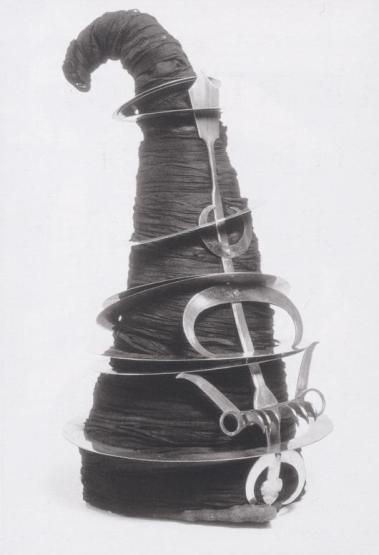
|
|
  |
 |
Bennison N

|
 Posted: Mon 21 Jul, 2008 5:10 pm Post subject: Posted: Mon 21 Jul, 2008 5:10 pm Post subject: |
 |
|
No problem, Julian... discussing Indian weapons is just another step closer, geographically, to discussing Chinese weapons... And then one more step and we're in wooden weapon heaven (Japan, Okinawa and the Phillipines), so to speak. Haha!
I knew that that wasn't the Madu you made, the wording of your post wasn't that difficult to understand. It was still a really nice one, though...
Yeah, I definitely lucked out when I went to India... I originally went there on a historical quest to find where Bodhidharma (Damo) was from and work backwards through China, following the development of Chinese Martial Arts, and hoping to get whipped enough times to actually learn something. I ended up staying much longer than I had planned, and my girlfriend of the time (who was Chinese and waiting there for me) thought I had been kidnapped or murdered or something.
I had a close friend with me to translate, and was able to get humiliated in front of about 300 people, over and over again, while wrestling with the biggest Indian guy I've ever seen (I let him win... haha!), see real life market demonstrations of Indian fighting (including Madu, and the rope trick by possible Fakirs), have wooden sword (broomsticks and tree branches used as swords really, but really fun) matches with members of the 1st Battalion (2nd Punjab) Guards Brigade of the Indian Army at their camp and train at a Kalari in Chandigarh. I was allowed to train there as long as I didn't take in a camera or a cellphone (probably because it had a camera), ate the same foods while I was there (simple vegetarian dishes) and promised never to tell exactly what they did in there. I still use the exercises I learnt there now, almost every day.
I can say that Kalaripayattu has a whole lot of different weapons systems and bases movements on those of animals even more than most forms of Indonesian Silat and most of the many Chinese animal styles of Unarmed Fighting do. It's amazing. If they weren't so secret about it, it would probably be a very popular Martial Art worldwide.
I can also say that everyone should go to India for a holiday at least once. It's a cool place... Elephants and cars in traffic together, marijuana growing down the side of the road (I'm not joking), some of the best food anywhere, and if you know where to look, a whole separate world of martial arts. It's awesome! Go there!
"Never give a sword to a man who can't dance" - Confucius
अजयखड्गधारी
|
|
  |
 |
|
Max Chouinard
Location: Quebec, Qc Joined: 23 Apr 2008
Posts: 108
|
 Posted: Wed 23 Jul, 2008 3:58 pm Post subject: Posted: Wed 23 Jul, 2008 3:58 pm Post subject: |
 |
|
| Jean Thibodeau wrote: |
Hello Maxime: maybe you can add some more about your training and research about the shillelagh on this Topic or start a specific Topic about them. 
For those who don't know, Max has done some serious research in Ireland about the Shillelagh but I won't say much more because I don't know how much he want to say about it here at this moment: Lets just say he found rare and difficult to access sources of information and I don't know what he is free to talk about or if he is keeping this stuff for a future book, martial arts course or article.
Just saying I don't know !  |
Hi Jean, sorry for the late response. I see no problem talking about it as I am actively trying to promote the style.
There are currently two traditional styles that I know of (that is with a verifiable lineage) and some reconstructed ones. The living lineages are the Doyle family style http://www.youtube.com/watch?v=REvuqH8cRJc and the Ramsey style. I learned the latter from John Ramsey while in Ireland last year and received permission to develop it here in Quebec, there are about 4 people who learned directly from him (Louie Pastore from UK, William Sanders from USA, my brother in law Emile Boudreau and me from Qc) and we are working on establishing some kind of a federation to promote and control it's practice. I wrote an article about it but still haven't translated it completely www.graspe.ca.
It is a very peculiar style and involves much more than hitting on each other franctically. It shares some traits with old style boxing and it seems that it is the closest thing to fighting with a long axe (it might actually be the same thing). It can be held one handed (the off hand protecting the plexus much like a shield) and two handed (much like in bastone siciliano).
Stick fighting went out of fashion by the end of the 19th century, and if it wasn't for the small renaissance it is going through could have completely disappeared. From what Mr. Ramsey told me, there are, as far as he know, 3 or 4 people left in Ireland who still practice it but unfortunately are not interested in teaching people outside their direct family (who are sometimes not interested in learning it anyway).
If you want to know more about it I suggest John w. Hurley's book; Shillelagh: the Irish fighting stick http://www.youtube.com/watch?v=REvuqH8cRJc. And for those who would be in Quebec city by the end of august, I am doing a free introduction class to the Ramsey style for the Celtic festival : http://www.festivalceltique.morrin.org/en/home.php
Maxime Chouinard
Antrim Bata
Quebec City Kenjutsu
I don't do longsword
|
|
   |
 |
Jean Thibodeau

|
 Posted: Wed 23 Jul, 2008 7:03 pm Post subject: Posted: Wed 23 Jul, 2008 7:03 pm Post subject: |
 |
|
Thanks Maxime and I'm glad you are promoting it rather than trying to keep it a secret.  
I just thought I should be prudent about how much to say about it without having your O.K. first.
Maybe you can give a day seminar on it with " Les Duellistes " eventually. ( Travelling isn't practical for me as I take care of my 88 year old Mom, so going to Quebec city doesn't work for me ).
Oh, I bough 3 of the Coldsteel shillelagh but I'm not sure if you would like them or not: One good thing is that for practice they are almost indestructible. They may be too flexible compared to wood and I think not as hard. They are moulded from solid polypropylene.
Anyway if you give a course I can bring them and you can minimize damage to your nice wooden ones I assume you have.
http://www.coldsteel.com/91pbs.html
A Canadian or American source for nice shillelagh might be nice to know if you know of one.
I guess the techniques would work with other kinds of walking stick ?
Playing with my 3' long Viking axe made by Eric McHugh I can sort of imagine how the use of a medium axe could similar to a heavy headed club: Basic balance being the same but the sharp edge of the axe may mean that lighter blows that might be ineffective with the club could be lethal with the axe.
http://www.myArmoury.com/talk/viewtopic.php?t...viking+axe
You can easily give up your freedom. You have to fight hard to get it back!
|
|
  |
 |
|
Max Chouinard
Location: Quebec, Qc Joined: 23 Apr 2008
Posts: 108
|
 Posted: Wed 23 Jul, 2008 8:59 pm Post subject: Posted: Wed 23 Jul, 2008 8:59 pm Post subject: |
 |
|
| Quote: | | Maybe you can give a day seminar on it with " Les Duellistes " eventually. ( Travelling isn't practical for me as I take care of my 88 year old Mom, so going to Quebec city doesn't work for me ). |
Of course if I get invited I would be glad to show a couple of concepts. Glen doyle is going to Montreal though like I said on les duellistes forum so you may want to try his style.
| Quote: | | Oh, I bough 3 of the Coldsteel shillelagh but I'm not sure if you would like them or not: One good thing is that for practice they are almost indestructible. They may be too flexible compared to wood and I think not as hard. They are moulded from solid polypropylene. |
I heard a bit about it from Glen Doyle, it seems he broke a couple of them (but then he's been doing this all his life) and says they re a bit heavy but are a good for developing strength and a replacement for a wooden one.
| Quote: | | A Canadian or American source for nice shillelagh might be nice to know if you know of one. |
I took mine in Shillelagh village, Ireland, I heard that there are some people making them in America but blackthorn is not a common species around here, I suppose oak would be an easier (and also traditional) choice. but there are many sources on the Internet, don't know much about the quality though. One of the people I train use an African knobkerrie, pretty much the same shape, sturdy and light.
| Quote: | | I guess the techniques would work with other kinds of walking stick ? |
Of course it could work with any walking stick as long as it is strong and heavy enough.
| Quote: | | Playing with my 3' long Viking axe made by Eric McHugh I can sort of imagine how the use of a medium axe could similar to a heavy headed club: Basic balance being the same but the sharp edge of the axe may mean that lighter blows that might be ineffective with the club could be lethal with the axe. |
I'd really like to try it with such an axe. From the writings and illustrations of Giraldus (12th-13th century), the way it was held was much the same, and it was used up until the 19th century.
Maxime Chouinard
Antrim Bata
Quebec City Kenjutsu
I don't do longsword
|
|
   |
 |
|
Max Chouinard
Location: Quebec, Qc Joined: 23 Apr 2008
Posts: 108
|
 Posted: Thu 24 Jul, 2008 10:33 am Post subject: Posted: Thu 24 Jul, 2008 10:33 am Post subject: |
 |
|
Talking about the knobkerry, the stick mostly associated with the famous Zulu warriors. Also called Shilluk in Sudan. Seems it is still in usage in some tribes, commonfolks and by policemen (here in kenya). Interestingly it seems it was also common practice to incise a mark each time you would win a fight with it, much like it was done in Ireland.
Also another trench club, this german one seems to have been filled with lead at his core, again a common practice in Ireland (called loaded stick). http://bp3.blogger.com/_cODTxzY0ZGg/RwqCJMkXC...-nails.jpg
 Attachment: 43.62 KB Attachment: 43.62 KB
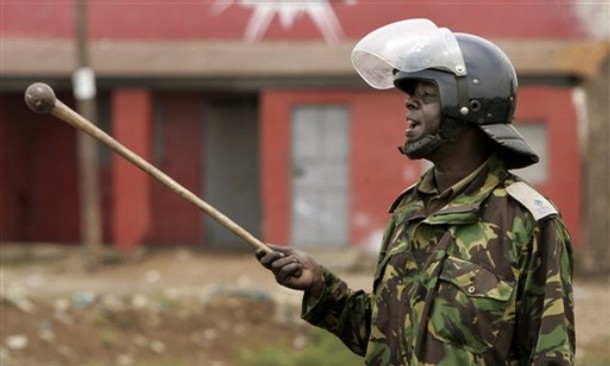
 Attachment: 52.16 KB Attachment: 52.16 KB
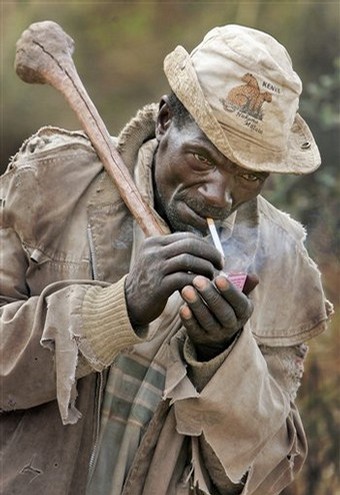
Maxime Chouinard
Antrim Bata
Quebec City Kenjutsu
I don't do longsword
|
|
   |
 |
|
Max Chouinard
Location: Quebec, Qc Joined: 23 Apr 2008
Posts: 108
|
|
   |
 |
Shahril Dzulkifli

|
 Posted: Fri 25 Jul, 2008 8:05 am Post subject: The Wooden Weapons Thread. Posted: Fri 25 Jul, 2008 8:05 am Post subject: The Wooden Weapons Thread. |
 |
|
Here is a Maori war club or Patu. The engravings symbolize facing and overcoming life's difficulties and challenges.

Last edited by Shahril Dzulkifli on Sat 26 Jul, 2008 10:24 am; edited 1 time in total
|
|
  |
 |
Bennison N

|
 Posted: Fri 25 Jul, 2008 9:01 am Post subject: Posted: Fri 25 Jul, 2008 9:01 am Post subject: |
 |
|
The meaning behind Maori carvings and tattoos, in particular the patterns, is defined by each individual creation and the emotional intent of the creator. For example, I have my left arm tattooed in a very similar pattern to that on Shahril's Patu, but it is to symbolise the members of my family.
You can also call these weapons Mere (interestingly, "patu" also happens to be a Maori slang word for disgusting or dirty, although the "T" is pronounced more as a "D" in that instance...), and they are the standard (certainly the most popular historically...) sidearm of a traditional Maori warrior. This is actually more like an axe than a club, as they are made with a fairly sharp edge and a thin profile, especially ones made from stone.
Attack-wise, they use short and very quick flicking hand movements, relying almost solely on wrist strength... and in a very logical and well developed system... For instance, a famous and widely taught but very rarely mastered (despite what a Maori fighter would say) technique with the Patu is said to invariably remove the entire top of the skull if performed correctly. Up close, this weapon is incredibly effective.
There are many varieties of Patu, and they are not only made of wood, but many different materials, including stone (especially greenstone, AKA nephrite) and bone (especially whale). The stone ones are far more prized than the wooden ones, but the more famous wooden ones are replicated far more often. The one in Shahril's photo is a good example of the most common shape, and it has the flaxen rope loop. This is to keep the weapon in the hand for certain twirling and grip-change techniques and is why there is a hole in the handle of every example I'll show you.
Another type I have photos of, as wooden, is called a Patuki. They are longer, with a thicker cross-section and a more pointed end (comparatively...).
 Attachment: 6.57 KB Attachment: 6.57 KB
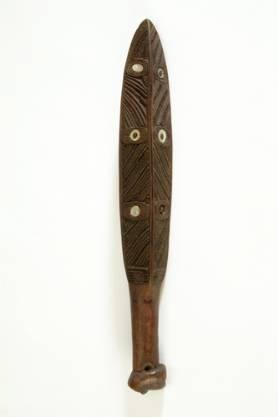
This one was acquired by the Auckland Museum from the Captain Gilbert Mair Collection in 1890.
 Attachment: 9.77 KB Attachment: 9.77 KB
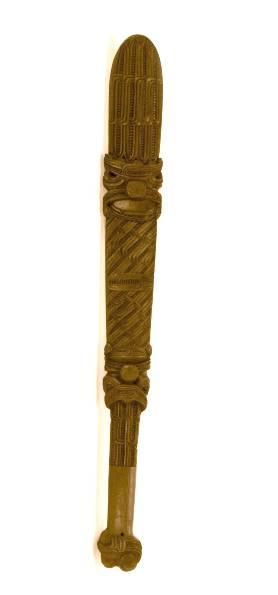
This one was acquired by Auckland Museum frm the Ngati Tuwharetoa tribe in 1887
"Never give a sword to a man who can't dance" - Confucius
अजयखड्गधारी
Last edited by Bennison N on Fri 25 Jul, 2008 11:21 am; edited 10 times in total
|
|
  |
 |
Bennison N

|
 Posted: Fri 25 Jul, 2008 9:23 am Post subject: Posted: Fri 25 Jul, 2008 9:23 am Post subject: |
 |
|
Another type is known as a Wahaika. The difference is obvious.
 Attachment: 12.72 KB Attachment: 12.72 KB
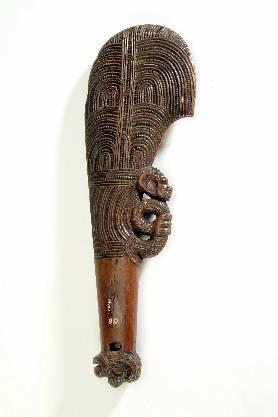
This one was acquired from the Captain Gilbert Mair Collection by Auckland Museum in 1890.
 Attachment: 7.98 KB Attachment: 7.98 KB
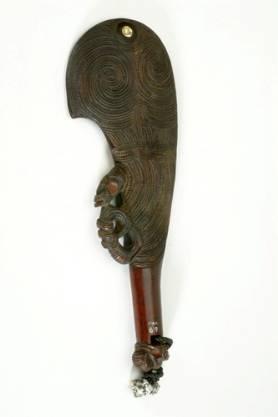
Also from the Captain Gilbert Mair Collection.
"Never give a sword to a man who can't dance" - Confucius
अजयखड्गधारी
|
|
  |
 |
Bennison N

|
 Posted: Fri 25 Jul, 2008 10:06 am Post subject: Posted: Fri 25 Jul, 2008 10:06 am Post subject: |
 |
|
One last type. Unfortunately, I was unable to find photos of wooden examples, but this type is known as Kotiate.
These particular Kotiate are both made from Whale Bone.
 Attachment: 10.19 KB Attachment: 10.19 KB
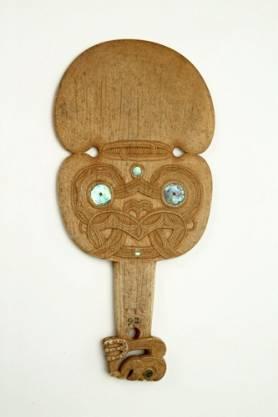
From Captain Gilbert Mair. Now in Auckland Museum.
 Attachment: 13.86 KB Attachment: 13.86 KB
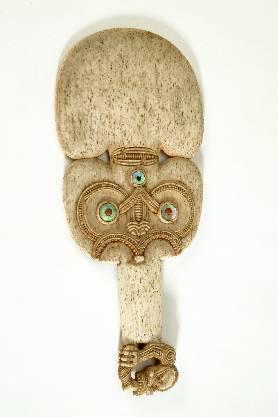
Once again, formerly of the Captain Gilbert Mair Collection.
"Never give a sword to a man who can't dance" - Confucius
अजयखड्गधारी
Last edited by Bennison N on Fri 25 Jul, 2008 10:35 am; edited 1 time in total
|
|
  |
 |
Bennison N

|
 Posted: Fri 25 Jul, 2008 10:32 am Post subject: Posted: Fri 25 Jul, 2008 10:32 am Post subject: |
 |
|
And as a bonus, because we have been discussing Maori weaponry quite a lot lately, I have some other pics to show you. Unfortunately I can't remember where I got them from, but I suspect it was the Dominion Museum in Wellington. I am almost entirely certain the Robley drawing print is from there.
The photo shows that which is fairly consistently what a Maori Warrior would historically take into battle, weaponry-wise. Of course, if he was more proficient in a certain weapon, he would carry a replacement. It appears that whoever this particular kit belonged to preferred the Taiaha, because there are two of them. There are some common types this Warrior didn't carry, but you get the idea, I hope.
The axe-head is rare, probably traded for land with a European Settler, as the Maori never developed metal-working technology before the arrival of Europeans. The Patu and the tomahawk (Patiti in Maori) head are made from stone (that is what onewa means...), but the rest is all wooden.
And of course a drawing by Major-General Horatio Gordon Robley (1840-1930), who fought in the Maori Wars, as an Ensign, from 1863 until 1866 (when he returned to England and was then sent to fight Mauritians and Zulus instead). It is of a Maori Warrior performing a pukana, which I mentioned earlier in the thread, and still liken to a Maori kiai...
Robley himself is a very interesting character. He collected the perfectly preserved, and entirely tattooed heads of Maori chiefs... A traditional Maori skill (they have a very secret and near-perfect preserving process) and show of respect for the tattoos (and the chiefs)... eventually having 35 of them, which he sold (except for 5) for 1,250 pounds sterling, sometime around 1908, to the Natural History Museum in New York.
 Attachment: 50.55 KB Attachment: 50.55 KB
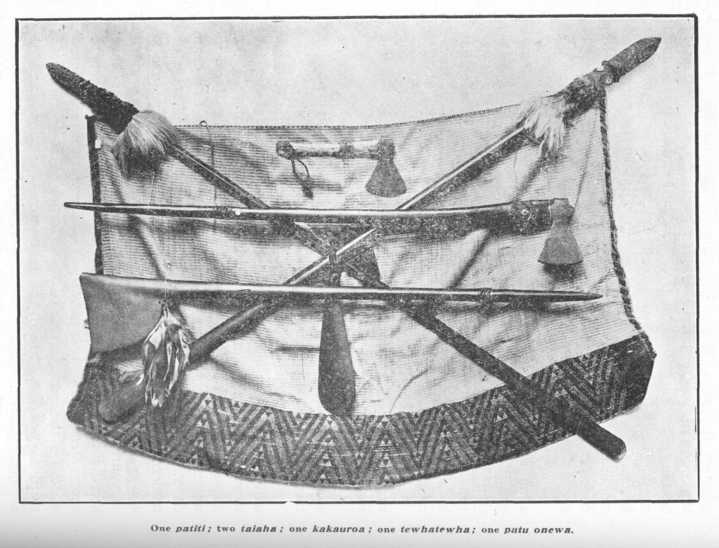
 Attachment: 36.27 KB Attachment: 36.27 KB
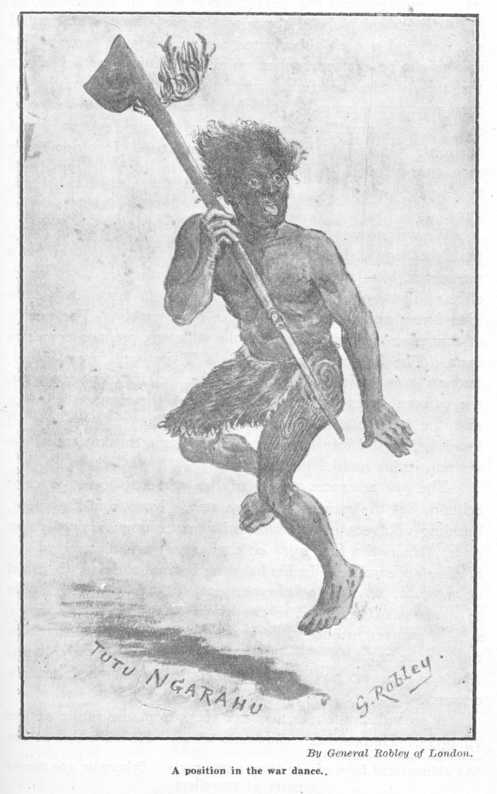
"Never give a sword to a man who can't dance" - Confucius
अजयखड्गधारी
|
|
  |
 |
|
Julian Reynolds
Location: United Kingdom Joined: 30 Mar 2008
Posts: 271
|
 Posted: Fri 25 Jul, 2008 2:39 pm Post subject: Posted: Fri 25 Jul, 2008 2:39 pm Post subject: |
 |
|
Bennison,
Here's a few more to add to your Maori weapons, including a rather nice 'Maripi' set with shark's teeth.
The final pic is from the Australian Museum, Sydney. After a 6 months at sea, eating salt beef and weevil-ridden biscuits, the last person I would want to meet on an island paradise, is this chap!
Julian
 Attachment: 24.37 KB Attachment: 24.37 KB
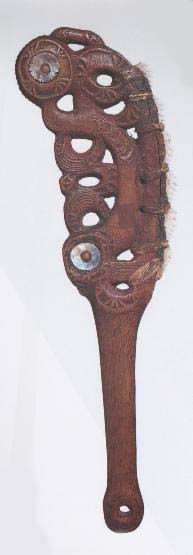
 Attachment: 10.09 KB Attachment: 10.09 KB

 Attachment: 20.03 KB Attachment: 20.03 KB
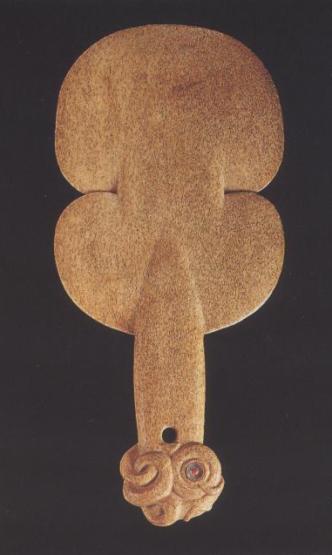
 Attachment: 30.86 KB Attachment: 30.86 KB
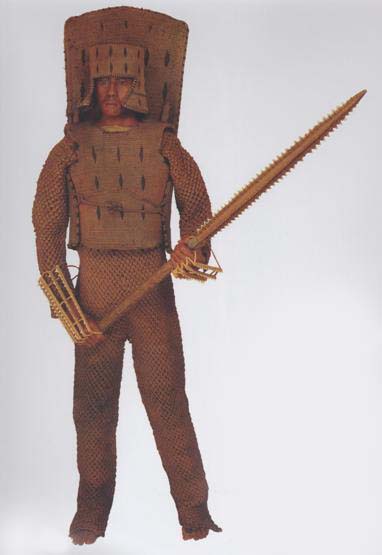
|
|
  |
 |
Bennison N

|
 Posted: Sat 26 Jul, 2008 12:50 am Post subject: Posted: Sat 26 Jul, 2008 12:50 am Post subject: |
 |
|
That Kiribati guy's armour is pretty cool, isn't it? You'd certainly hope your powder was dry and your sword was sharp if you saw that running at you screaming, wouldn't you?
That is a really nice Maripi as well. I have heard, however, that Maripi are really more a cutting tool than an actual battle weapon. I would definitely wager that a lot of them were used as weapons, though... Especially if a band of slave-hunters from another tribe rocked into your village and started tying everyone up. I could see Maori women, who are every bit as tough as the men, grabbing whatever they had close to hand to defend their Marae, and for a while there in Maori history, to avoid being dinner...
"Never give a sword to a man who can't dance" - Confucius
अजयखड्गधारी
|
|
  |
 |
Shahril Dzulkifli

|
 Posted: Sat 26 Jul, 2008 10:28 am Post subject: The Wooden Weapons Thread. Posted: Sat 26 Jul, 2008 10:28 am Post subject: The Wooden Weapons Thread. |
 |
|
Bennison,
For your information the Patu pictured above doesn't belong to me. I took it from some website.
Actually I did not know what are the meanings behind every Maori carving. Because you're from New Zealand you must be an expert on this.
|
|
  |
 |
Bennison N

|
 Posted: Sat 26 Jul, 2008 11:45 pm Post subject: Posted: Sat 26 Jul, 2008 11:45 pm Post subject: |
 |
|
Shahril,
It was a nice Patu. It didn't look like the usual tourist item you see most often these days.
Hey, if that's what the website said that the carvings mean, then that'll be it. Each individual carving has the meaning that the carver gives to it. Maori artists put a lot of emotion into their work... I apologise if I somehow offended you with my earlier post, mate.
I'm certainly not an expert on this, but have had a lot of exposure to it (it is our second language after all, and basic phrases and folksongs are taught from the earliest days of school...), and I'm a very small part Maori by blood. This, and the fact that I participated in many warrior-training exercises and challenge matches over the years, is the reason I have the warrior tattoo. I'm very lucky to have been offered the opportunity to have this traditionally done, most people just go and get one at a tattoo parlour because they like the patterns.
To be perfectly honest, not many Maori are experts either... these days. The experts are few and far between, but they are incredibly knowledgeable on the subject. I knew one once. My close friend's late mother was often said to be a Tohunga, which is like a sorcerer or prophet of the old ways of Maori Makutu, which can be likened to Voodoo or magic, I suppose. I asked her about that, she denied it, and we never discussed it again, but she really knew almost all there was to know about carvings, legends and the like. That level of knowledge is very rare indeed.
"Never give a sword to a man who can't dance" - Confucius
अजयखड्गधारी
|
|
  |
 |
Shahril Dzulkifli

|
 Posted: Tue 29 Jul, 2008 9:38 am Post subject: The Wooden Weapons Thread. Posted: Tue 29 Jul, 2008 9:38 am Post subject: The Wooden Weapons Thread. |
 |
|

A pre-1870 Sioux war club from the Cheyenne River Reservation, now kept at the University of Pennsylvania Museum of Archaeology and Anthropology, Philadelphia.
|
|
  |
 |
Bennison N

|
 Posted: Tue 29 Jul, 2008 5:02 pm Post subject: Posted: Tue 29 Jul, 2008 5:02 pm Post subject: |
 |
|
Shahril,
Do you know what that ball-head is made from, by any chance? The spike certainly looks metallic, so maybe the ball is as well.
That's an awesome weapon... You definitely wouldn't want to get in the way of that, would you? I would say, imagining the way that that head would distribute the weight, and the power you could build in a swing, that it would pretty much pierce anything that was in front of it.
I found this picture of some replicas of very old Native American War Clubs, from the Cocopah Tribe, originally of California. I hope the big ol' webpage address smack in the middle doesn't ruin the intimidation effect of these awesome primitive wooden weapons (Mesquite wood) too much. The cochineal dye on some of these is a sign of status for that tribe, and as we know, is made of crushed insects...
The club in the middle is 16 inches tall, and weighs over 5 pounds. A very powerful man would have used the original that was based on...
 Attachment: 99.81 KB Attachment: 99.81 KB
[ Download ]
"Never give a sword to a man who can't dance" - Confucius
अजयखड्गधारी
|
|
  |
 |
|
Lafayette C Curtis
|
 Posted: Wed 30 Jul, 2008 5:47 am Post subject: Posted: Wed 30 Jul, 2008 5:47 am Post subject: |
 |
|
| Julian Reynolds wrote: | | The final pic is from the Australian Museum, Sydney. After a 6 months at sea, eating salt beef and weevil-ridden biscuits, the last person I would want to meet on an island paradise, is this chap! |
Does anybody know the philosophy behind the armor's design? I'm thinking that the large screen mounted behind the head looks suspiciously like it's meant to ward of "friendly fire" from missile-throwers behind the wearer, but of course I don't know how far that idea is to the truth.
|
|
  |
 |
|
|
You cannot post new topics in this forum
You cannot reply to topics in this forum
You cannot edit your posts in this forum
You cannot delete your posts in this forum
You cannot vote in polls in this forum
You cannot attach files in this forum
You can download files in this forum
|
All contents © Copyright 2003-2024 myArmoury.com — All rights reserved
Discussion forums powered by phpBB © The phpBB Group
Switch to the Basic Low-bandwidth Version of the forum
|

